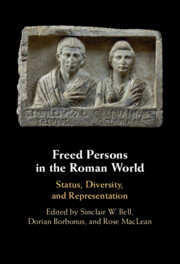Book contents
- Freed Persons in the Roman World
- Freed Persons in the Roman World
- Copyright page
- Contents
- Figures
- Table
- Contributors
- Acknowledgments
- Bibliographical Note
- Introduction
- 1 Permissu decurionum
- 2 Freed Public Slaves in Roman Italy and the Western Provinces
- 3 Fitting in by Decree
- 4 Doubling Up
- 5 The Cost of Ingratitude
- 6 Between Moral Slavery and Legal Freedom
- 7 Framing the Freed Person
- 8 Novel Evidence for Ancient Freed People
- 9 The Affects of Manumission
- General Bibliography
- Index
- References
1 - Permissu decurionum
Freed Persons and Burial Management in the Collective Tomb of the Volusii*
Published online by Cambridge University Press: 16 May 2024
- Freed Persons in the Roman World
- Freed Persons in the Roman World
- Copyright page
- Contents
- Figures
- Table
- Contributors
- Acknowledgments
- Bibliographical Note
- Introduction
- 1 Permissu decurionum
- 2 Freed Public Slaves in Roman Italy and the Western Provinces
- 3 Fitting in by Decree
- 4 Doubling Up
- 5 The Cost of Ingratitude
- 6 Between Moral Slavery and Legal Freedom
- 7 Framing the Freed Person
- 8 Novel Evidence for Ancient Freed People
- 9 The Affects of Manumission
- General Bibliography
- Index
- References
Summary
This chapter discusses a group of inscriptions that include formulas granting permission for burial in a collective tomb on the Via Appia. These epigraphic formulas speak to the careful management of a resource that was of importance in a community in which enslaved and freed persons constituted the majority: the successful acquisition of a respectable burial. Curiously, these permissions are sometimes given out by the decurions of an association and in other cases by the aristocratic patriarchs. This suggests that the agency to grant these permissions did not rest exclusively with either enslavers or dependents, but more importantly the epigraphic commemoration of these arrangements may pay deference to the authority of the association and the aristocratic patrons. Taken as a group, the inscriptions thus appear to reflect a carefully choreographed interaction between enslaved, manumitted, freeborn, and aristocratic members of the gens Volusia. This reading complements interpretations of freed persons’ funerary culture as self-representations by positing that these funerary monuments are also concerned with securing burial privileges in the collective tomb.
Keywords
- Type
- Chapter
- Information
- Freed Persons in the Roman WorldStatus, Diversity, and Representation, pp. 30 - 55Publisher: Cambridge University PressPrint publication year: 2024



